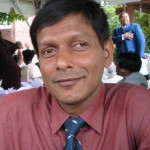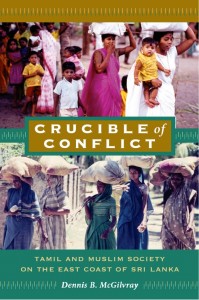
Ilankai Tamil Sangam
Association of Tamils of Sri Lanka in the USA
Published by Sangam.org
by Dr. Imtiyaz Razak, Colombo Telegraph, July 19, 2012
|
There are very few studies on Sri Lanka that employ anthropological tools to understand ethnic conflict and the cultural identities of the ethnic groups in that country. The book under review progressively fills that scholarly gap and offers thoughtful insights to readers. It provides a combination of anthropological narratives and analytical information, thus making the volume appealing to both general readers and scholars of Sri Lanka’s ethnic conflict... In fact, a recent study of the Eastern Muslims suggests that competition for resources and security was a key source of tension between the Tamils and the Muslims. Elites aggravate such tensions among the people, rather than seeking political-social solutions. |
 |
| Dr. Imtiyaz Razak |
BOOK REVIEW: Dennis B. McGilvray, Crucible of Conflict: Tamil and Muslim Society on the East Coast of Sri Lanka(Durham, NC: Duke University Press, 2008), ISBN 978-0-8223-4163-1, xiv fl 425 pp., $US99.95 hdbk., $US24.79 pbk.
The ethnic conflict between the Tamils and the Sinhalese entered into another crucial phase in May 2009, when Sri Lanka’s Sinhala-dominated security forces disabled the Liberation Tigers of Tamil Eelam (LTTE, the separatist Tamil organization established in 1976). Sri Lanka’s post-war policies are a hindrance to reconciliation between the country’s disillusioned Sinhalese and Tamils, who share the land and culture with the ethnic Moors or Muslims of eastern Sri Lanka. Dennis B. McGilvray’s study attempts to understand the complex issues and myriad problems of the ethnic Tamils and Muslims of the Eastern Province. There are very few studies on Sri Lanka that employ anthropological tools to understand ethnic conflict and the cultural identities of the ethnic groups in that country. The book under review progressively fills that scholarly gap and offers thoughtful insights to readers. It provides a combination of anthropological narratives and analytical information, thus making the volume appealing to both general readers and scholars of Sri Lanka’s ethnic conflict.
 McGilvray aims to unpack the complexities behind the ethnic relations between the Tamils, who speak Tamil and claim they are being discriminated against by the Sinhala-dominated government, and the (Eastern) Muslims, who also speak Tamil with some borrowed Arabic words, but who seek a social formation based on religion
to win a distinct ethnic recognition—distinct from the Tamil ethnic group. McGilvray assertively attempts to explain why these groups, who speak the same language and share elements of culture, often hate each other. In answering this question, he adopts an ethnographic approach, paying close attention to interactions between the Tamils and Muslims at the plebeian as well as elite levels observed during his fieldwork conducted between 1970 and 1980. McGilvray explores a number of primordial as well as constructed ethnic identities of Tamils and Muslims (p.11). He easily guides readers to understand social and religious institutions such as temples and mosques and how they bear upon the Muslim and Tamil publics in their
respective ethnic territories. His accounts pensively explain the degree of influence these institutions hold over the political institutions and the actions of the local communities of Tamils and Muslims in eastern Sri Lanka.
McGilvray aims to unpack the complexities behind the ethnic relations between the Tamils, who speak Tamil and claim they are being discriminated against by the Sinhala-dominated government, and the (Eastern) Muslims, who also speak Tamil with some borrowed Arabic words, but who seek a social formation based on religion
to win a distinct ethnic recognition—distinct from the Tamil ethnic group. McGilvray assertively attempts to explain why these groups, who speak the same language and share elements of culture, often hate each other. In answering this question, he adopts an ethnographic approach, paying close attention to interactions between the Tamils and Muslims at the plebeian as well as elite levels observed during his fieldwork conducted between 1970 and 1980. McGilvray explores a number of primordial as well as constructed ethnic identities of Tamils and Muslims (p.11). He easily guides readers to understand social and religious institutions such as temples and mosques and how they bear upon the Muslim and Tamil publics in their
respective ethnic territories. His accounts pensively explain the degree of influence these institutions hold over the political institutions and the actions of the local communities of Tamils and Muslims in eastern Sri Lanka.
In patriarchal societies, ethnicity plays a central role in sharing or negotiating power. Social-political forces attempt to use ethnicity when they seek an easy passage to power. Such social and political mobilisations could lead to suspicion, tension and violent conflict when ethnic leadership provides strong networks for a particular community. Moreover, when rival communities expand their farming or grazing into already-occupied land, this often leads to sharp competition over land, which is likely to take on an ethnic colour and can develop into outright confrontation. Understanding this helps us grasp the situation of the Muslims of the Eastern Province, who claimed that their lands were being forcibly confiscated by the LTTE. These Muslims often complained about being harassed by the Tamils: for instance, when they passed through adjacent Tamil villages, their vehicles were waylaid, or they were robbed of their paddy and cattle. In fact, a recent study of the Eastern Muslims suggests that competition for resources and security was a key source of tension between the Tamils and the Muslims. Elites aggravate such tensions among the people, rather than seeking political-social solutions.
McGilvray’s study also acknowledges these dynamics of the Sri Lankan political formation (pp.325–9). The book guides readers to a comprehensive understanding of the century-old divisions among the Tamils and Muslims along caste and class lines. Importantly, McGilvray challenges the putative stereotype of the Muslims of Sri Lanka, particularly those in the Eastern Province, as a business community. The author states that ‘66 percent of the Muslims are cultivators (versus 54 percent of the High Caste Tamils) while the Muslim category of laborer (2 percent) is much smaller than among the Tamils (20 percent)’. He further states that ‘landlessness was nearly the same in both communities (41 percent of Tamils, 38 percent of Moors)’ (p.268).
As for the sources of existing tension and deep mistrust between the Tamils and Muslims, as an anthropologist, McGilvray provides some rational explanations. But the question is whether this mistrust was engineered by the elites for political mobilisation or it was inborn among the people. Somehow, McGilvray fails to fully appreciate the key logic of constructivism in the ethnic morass in eastern Sri Lanka. In my view, ethnic identities, relations and moves are a product of human actions and choices and, thus, they are constructed and transmitted, not inherited from the past.
Careful observation of the Muslims and Tamils in Akkarapathu, a town in Ampara District, and the larger Batticaloa region of eastern Sri Lanka, would explain how ethnic identities are being methodically constructed by the elites of the different ethnic groups for political gain.
McGilvray clearly explains the complexities of the primordial values of Tamil and Muslim relations at the popular level and the way difficulties between the Tamil and Muslim masses are constructed by the elites of both communities for political purposes, as well as power struggles at the elite level itself. In so doing, his book investigates what is ‘ignored in most journalistic accounts of the Eelam conflict [which] . . . will affect the prospect of interethnic peace and economic development throughout the eastern region (p.11)’. McGilvray’s book is a major work by a Western scholar on the Tamils and Muslims of eastern Sri Lanka and is a valuable resource for students of anthropology in general, and students of ethnic conflicts in particular. His book adds an important dimension to the analytical framework of Tamil–Muslim relations and conflict.
http://dx.doi.org/10.1080/00856401.2012.687854
1)A.R.M. Imtiyaz, Tamil Insurgency Sri Lanka, in Orlando Patterson and Geoffrey J. Golson (eds), Cultural Sociology of the Middle East, Asia, and Africa: An Encyclopedia (Sage Publications, 2012).
2)A.R.M. Imtiyaz, Taliban and Al Qaeda in Orlando Patterson and Geoffrey J. Golson (eds), Cultural Sociology of the Middle East, Asia, and Africa: An Encyclopedia (Sage Publications, 2012).
3)A.R.M. Imtiyaz, Falun Gong (Falun Dafa) in Orlando Patterson and Geoffrey J. Golson (eds), Cultural Sociology of the Middle EastAsia, and Africa: An Encyclopedia (Sage Publications, 2012).
4)A.R.M. Imtiyaz (2012), Identity, Choices and Crisis : A Study of Muslim Political Leadership in Sri Lanka, Journal of Asian and African Studies. To link to this article,http://jas.sagepub.com/content/early/2012/05/04/0021909612438518
5)A.R.M. Imtiyaz, (2012): Crucible of Conflict: Tamil and Muslim Society on the East Coast of Sri Lanka, South Asia: Journal of South Asian Studies, 35:2, 497-499. To link to this article: http://dx.doi.org/10.1080/00856401.2012.687854
(Dr. A.R.M. Imtiyaz’ research and teaching are mainly focused on ethnic politics. He has published widely in peer-reviewed international journals. He currently teaches at the Asian Studies/Department of Political Science, Temple University, Philadelphia, USA.
© 1996-2025 Ilankai Tamil Sangam, USA, Inc.